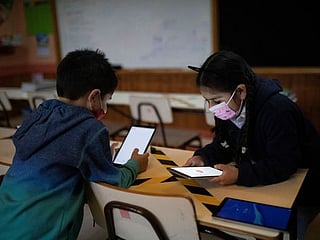Happy with hybrid work? 7 trends to know
Video: Hybrid work is here to stay and it pays to know forces at play

Also In This Package
The “workplace” has been disrupted. It no longer refers to a specific physical location; rather, it’s asymmetric. Some call it the “blended” work mode. So, while many return to their traditional workplace as the pandemic wears off, others continue working remotely.
Now, the world of work faces another disruption. The key drivers: cost, productivity and technology. For many businesses and professionals, there's no going back. The pandemic-driven shift is here to stay. Industry experts say it's only bound to accelerate. These are the key trends to watch:
1. Hybrid work: A part of the mix, and more
The pandemic has disrupted our world, but work never stopped. It took another form, evolved. So remote work will not only be part of the mix, but will most likely accelerate Globally, the share of team members on a permanent remote work mode is projected to double — to 34.3% compared to the pre-pandemic 16.4%, a poll by the Enterprise Technology Research shows.
The goal posts moved elsewhere. The pandemic forced this move. In March 2021, Microsoft unveiled its hybrid work strategy for the company’s 160,000+ employees. In May 2021, CEO Sundar Pichai shared Google’s own approach to hybrid work for the company 140,000+ staff. The key message of such moves? Allow flexibility for employees. In-person work has its value. But so does remote work, including reduced cost, travel, insurance, traffic, emissions and expanded talent pool.
Lesson: In a post-pandemic world, value of remote work will remain.
2. Hybrid work is not for everyone - yet
The tools available to man — from stone to AI — define every era. By definition, remote work has always been with us, from the time of hunter-gathering societies. Fishermen, farmers, soldiers, train engineers, etc. are, by nature, remote workers. Futurist Peter Diamandis, in his book “Abundance”, pointed out that in 1790, 90% of all Americans made their living as farmers; today it’s less than 2%. But farming jobs did not disappear. Machinery has transformed agriculture.
Then genetic engineering came (with genetically modified foods), and now by AI, too. Certainly, construction, healthcare, assembly-line jobs, flying and dozens of other jobs will not be the stuff of remote work — but maybe not for long. Assembly-line work and face-to-face board meetings are fairly recent inventions, arising from the Industrial Revolution.
Technology is a key determinant. In the not-too-distant future, 3D printing could change the nature of construction; robots could disrupt assembly-line work; telemedicine and genome sequencing are changing healthcare; full self-driving technology may disrupt cabbies; AI could further change agriculture or vertical farming.
Lesson: Our tools define the nature of work.
3. Productivity and real 'presence' go together
For some, remote or “hybrid” work can prove admirably more productive. Is it possible for remote workers to match — even surpass — the productivity of in-person work before the pandemic? The answer hinges on these: employee health, well-being and satisfaction, as well as digital experience and engagement. A survey of remote workers by Morning Consult and The New York Times showed 86% were satisfied working from home.
The interaction with remote staff should be such that high-quality work is made possible. A Pricewaterhouse Coopers poll published in January 2021 reported more than one-third (34%) of employees and more than half (52%) of employers believe productivity has improved over prolonged working from home during the pandemic.
The pandemic has ushered in the primacy tech-enabled productivity. Sam Tayan, Zoom Managing Director for Middle East and North Africa (MENA) told Gulf News: “You know, if we were to get together in the same place for this very same meeting, there’d be travel, driving, traffic, and all sorts of things. Maybe a little bit of lateness, because people coming from different locations… not to mention parking. Imagine if we’re from international locations, it would be even more difficult…As we move out of 2021, and further on to 2022, I think we’ve all learnt the benefits of virtual and hybrid working.”
Lesson: Increased productivity via remote is not only possible, but sustainable.
Zoom mania
Back in 2019, Zoom had 10 million daily users; this jumped 20x to 200 million by March 2020; and then to 300 million daily users by April 2020. Zoom’s market cap hit more than $100 billion billion, now back down to a decent $88.6 billion, still more than the combined market cap of world’s 7 leading airlines. It shows how video conferencing has "dematerialised" or "demonetised" travel around the world.
4. IT holds the key
The quality of digital experience by people working both on-site and remotely hinges on IT. It starts from newcomer-initiation to network availability. On the remote side, a big variable is the quality of communications infrastructure. This is still a major challenge, especially in the developing world. When the tens of thousands of satellites (StarLink/OneWorld/Kuiper) go live, this problem may be history. Coverage of fibre-to-the-home services, meanwhile, is also getting cheaper, and wider.
We have lots of customers who talk to us about hybrid work. We have, for example, something called Zoom Rooms. They are room systems which offer everything from digital signage, to advanced features can take a look at how many people are in the room, avoid overcrowding, a kind of system for checking in…That kind of hybrid working is something customers are talking to us a lot about.Sam Tayan, Zoom Managing Director for MENA
"We have lots of customers who talk to us about hybrid work,” said Tayan. “We have, for example, something called Zoom Rooms. They are room systems which offer everything from digital signage, to advanced features can take a look at how many people are in the room, avoid overcrowding, a kind of system for checking in…That kind of hybrid working is something customers are talking to us a lot about.”
It's not just remote meetings and cross-border collaborations. The IT revolution, driven by miniaturisation, has unleashed other disruptions — artificial intelligence, blockchain technology, energy storage, robotics/3D printing, genome sequencing, and the so-called internet of things (IoT).
There are an estimated 35 billion smart devices connected today. This will jump to 75 billion by 2025 (> 1 trillion market by 2027), already including smart vehicles, medical devices, smart factories using a lot of robotics, etc.
Lesson: The internet is the new utility, in addition to power and water.
5. Data is the new gold
Data is the new currency. Big data systems are today key business enablers. They help reach new customers, create new revenue streams, customise services and improve efficiency.
This is true even for media houses, where real-time audience engagement has become a key metric. The reliability, and safety of such tools will be the key challenge. Strategising and decision making based on accurate and secure data analytics is no longer the exclusive domain of big businesses.
Take, for example, cryptocurrencies — the irony of how openness (through decentralised ledgers) becomes its own guarantee of security. Result: The global blockchain technology market size jumped from approximately $242.4 million market value in 2016 to $3.67 billion in 2020, further projected to reach $394.60 billion by 2028, according to a Grand View Research report. It shows data is no longer just the new gold. Data is the world’s most valuable resource.
Meawhile, access to to the so-called "cloud" enabled by cheap and powerful servers, has become the energy behind the explosion of exponentially empowered entrepreneurs, pushing big companies like Kodak to has-beens. It shows data is no longer just the new gold. Data is the world’s most valuable resource.
Lesson: Data is morev valuable than money.
5G everywhere
Faster communications and wider adoption of broadband — from 13 million in 2019 to 3 billion — 11x jump in end users — by 2025, according to Ericsson. We’re just 3 to 4 years away from that, the world is now on track to get to the that 3 billion mark for 5G mobile subscriptions.
6. Innovation drives integration, which drives even more innovation
It started around 1965, with Gordon Moore, one of the founders of Intel. "Moore's Law", which remains unbroken since then, refers to Moore's observation that the number of transistors on a microchip doubles every two years, though the cost of computers is halved.
Faster chips is the reason why smartphone used by today's kids is more power powerful than anything Ronald Regan saw or used as president in 1984. Video has become the dominant communication tool. Every day, people consumes more than 1 billion hours of Youtube content. It’s become arguably the world’s biggest school (people spent an average of 11.24 minutes per day in 2020 on Youtube. Streaming has platforms like Netflix (aka “OTT”, or over the top services) has disrupted the entertainment industry.
Faster speeds of change will only drive more innovation. We see it in education/training, banking, healthcare and insurance. Virtual and augmented reality have already begun to disrupt the training profession, with ABI Research projecting the enterprise AR/VR training market is on track to exceed $6.3 billion in value by 2022.
The primacy of video as a communication and education tool has dislodged everything before it — the sermon, the book, theatres, newspapers, radio, TV. High speed, broadband communication anywhere is now a reality for an increasing number of people.
Communication will be even more ubiquitous. A new chip now offers 6G, up to 100x faster than 5G connection speeds — fast enough to download 142 hours of Netflix in a second. Even if it’s a bit off (researchers now able to transmit data at 11 gbps), I won’t complain (how many movies can you watch in an hour?). Innovation forms a virtuous cycle.
Lesson: As the tools we use change, so does our means of livelihood.
7. Try and imagine what happens tomorrow
So we have miniaturised chips and powerful smartphones today. But the progress of computing power will not stop. Stretch your imagination and try to see where it’s going. Given Moore's Law, 10 years from now, computers will be 1,000 times better; 20 years from now 1 million times better; 30 years from now, 1 billion times better.
With the global sensor explosion, the notion that you can know anything you want anytime you want is what’s happening. Here's the takeaway: everything that’s digitised enters a period of "deceptive growth", an improvement that's deceptively incremental in value accumulation. So prepare for 5 Ds: disruption, digitisation, deceptive growth, dematerialisation, demonetisation and democratisation.
Then it just accelerates — or zooms like a rocket — a growth so disruptive that it "dematerialises" and "demonetises" things. "Dematerialise" simply means things that are bulky today will fit in your pocket, or in your clothing in the not-too-distant future. "Demonetise" means the ability of technology to take a product or service that was previously expensive and making it substantially cheaper (accessible to everybody, i.e. democratisation).
So faster and cheaper computers have become the growth medium for which all of these stuff are happening — pervasive networks, AI, ubiquitous sensors, robotics, 3D printing, synthetic biology, telemedicine. They will eventually become pervasive.
Think of the opportunities that will rise out of these changes. So prepare for so-called 6 Ds: disruption, digitisation, deceptive growth, dematerialisation, demonetisation and democratisation. Whether you grab it or not is then up to you.
Lesson: Change never stops.
Sign up for the Daily Briefing
Get the latest news and updates straight to your inbox









